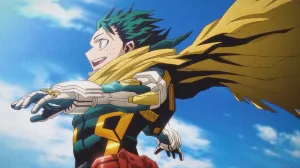John Higgins, a longtime contributor to the UK’s popular 2000 AD comics magazine and a prolific artist in his own right, is best known to most fans as the colorist behind Alan Moore and Dave Gibbons’ seminal superhero epic Watchmen. He’s also, along with series editor Len Wein, working on The Curse of the Crimson Corsair, a backup story that runs through all seven of this summer’s Before Watchmen miniseries and is being collected for free on DC’s website.The story is a callback to The Curse of the Black Freighter, the heavily-stylized “pirate story” that ran through the original Watchmen. Freighter was an in-story comic book, being read by one of the characters in Watchmen, which served as a kind of thematic parallel to the story but was not actually “happening” in the context of the world of Watchmen. In that world, it was explained, the existence of real-life superheroes had compromised fan interest in reading their stories in comic books, and other genres (notably pirate comics) took over the medium in their absence.Higgins joined ComicBook.com to talk about The Curse of the Crimson Corsair and the perks and challenges of being the only creator whose name has been on every book ever to say “Watchmen.”I remember when the Watchmen feature film came out, and there was a lot of talk about the “pirate story.” It ran the gamut from “It isn’t Watchmen without it” to “Don’t you dare.” Whose idea was it for you guys to take on a new interpretation of the idea in Curse of the Crimson Corsair?DC as far as I know, Dan Didio was the person who approached me with the idea of my involvement and Len came up with the title.This “pirate story,” though, is very different from the first, right? As the colorist you have to have a very different take on this, versus the self-consciously retro look of the original. The style in which the Crimson Corsair stuff is done actually has very little in common with the Black Freighter, other than the fact that the pair of them are both pirate stories. Did the variety of art styles at play in Before Watchmen give you a little more leeway to draw it like yourself and not feel like you have to synch up with the lead features?
Tales
Before Watchmen
Before Watchmen
Curse of the Crimson Corsair
So far, we’ve seen the subtitle “Devil in the Deep” on both issues released. Will that be the subtitle of the eventual collected edition, and so the one used on all of the backup features, or will there be more than one as you get past the length of what would ordinarily be a single-issue comic?
You’re the only creator whose name will, by the time all is said and done, have appeared on every Watchmen issue published, right? I mean, there’s Len, but he was on editorial and not creative the first time around.That said, was it tempting to credit this to Tony Orlando or whomever it was that the Black Freighter story was supposed to have been done by?
Curse of the Crimson Corsair
Watchmen
Tales of the Black Freighter
Watchmen
Tales of the Black Freighter
Watchmen
Tales of the Black Freighter
Curse of the Crimson Corsair
Watchmen
Watchmen
Ironically, the thing that I thought of when I first saw the style and the colors on this story was Palmiotti & Gray’s All-Star Western. Then I remembered that you’ve worked with them on Jonah Hex before. Was there a similar approach between the two projects or is that just me projecting?
Watchmen
Crimson Corsair
Is it challenging to try and make something worthwhile happen in only two pages at a hit, and still make it flow with the previous and forthcoming chapters? I remember talking to friends of mine who were doing those 10-page “Second Feature” stories that DC did a few years back and they were always a bit harried trying to pace out a story at half-length.
2000 AD
Certainly the controversy surrounding Before Watchmen must affect you and Len a bit. Is it frustrating to hear people talking out of school, being that you presumably have opinions but want to stay on good terms with all involved?
Before Watchmen
In much the same way Watchmen brought the comics-and-graphic novels genre some credibility in the mainstream marketplace of ideas back in the ’80s, it seems to me as though your work with Moore made comics fans reconsider the importance and impact of the colorist on the work. Would you say that’s a safe assessment?
Watchmen
That asked, did you have any qualms about joining this project when you were invited aboard? If so, how were you won over?
You’ve been around the industry for a while, but also worked outside of comics. Obviously the comics industry has a reputation for evolving a little more slowly than most others, so is it heartening to see something like DC putting the Crimson Corsair story online in “realtime”?
Crimson Corsair













